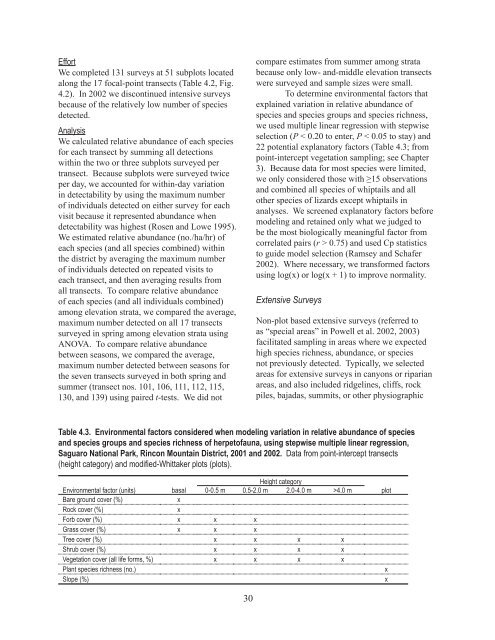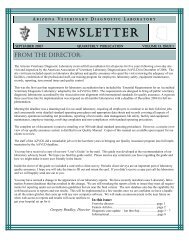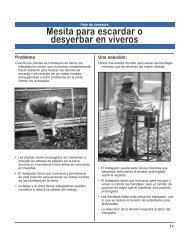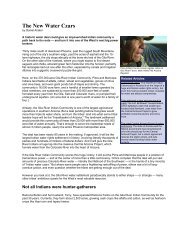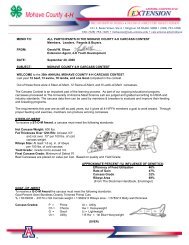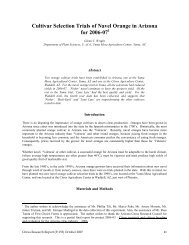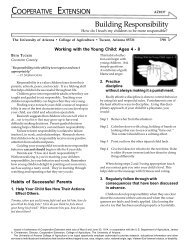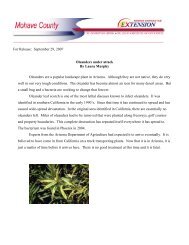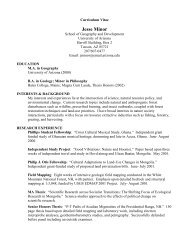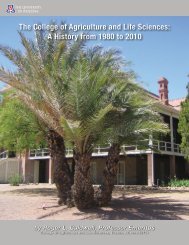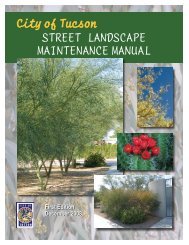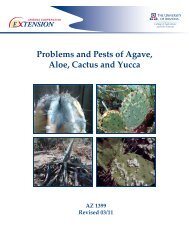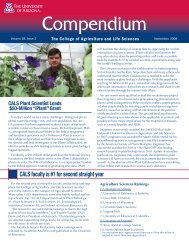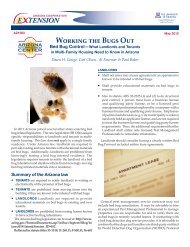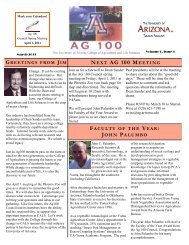Details - CALS Networking Lab - University of Arizona
Details - CALS Networking Lab - University of Arizona
Details - CALS Networking Lab - University of Arizona
Create successful ePaper yourself
Turn your PDF publications into a flip-book with our unique Google optimized e-Paper software.
Effort<br />
We completed 131 surveys at 51 subplots located<br />
along the 17 focal-point transects (Table 4.2, Fig.<br />
4.2). In 2002 we discontinued intensive surveys<br />
because <strong>of</strong> the relatively low number <strong>of</strong> species<br />
detected.<br />
Analysis<br />
We calculated relative abundance <strong>of</strong> each species<br />
for each transect by summing all detections<br />
within the two or three subplots surveyed per<br />
transect. Because subplots were surveyed twice<br />
per day, we accounted for within-day variation<br />
in detectability by using the maximum number<br />
<strong>of</strong> individuals detected on either survey for each<br />
visit because it represented abundance when<br />
detectability was highest (Rosen and Lowe 1995).<br />
We estimated relative abundance (no./ha/hr) <strong>of</strong><br />
each species (and all species combined) within<br />
the district by averaging the maximum number<br />
<strong>of</strong> individuals detected on repeated visits to<br />
each transect, and then averaging results from<br />
all transects. To compare relative abundance<br />
<strong>of</strong> each species (and all individuals combined)<br />
among elevation strata, we compared the average,<br />
maximum number detected on all 17 transects<br />
surveyed in spring among elevation strata using<br />
ANOVA. To compare relative abundance<br />
between seasons, we compared the average,<br />
maximum number detected between seasons for<br />
the seven transects surveyed in both spring and<br />
summer (transect nos. 101, 106, 111, 112, 115,<br />
130, and 139) using paired t-tests. We did not<br />
30<br />
compare estimates from summer among strata<br />
because only low- and-middle elevation transects<br />
were surveyed and sample sizes were small.<br />
To determine environmental factors that<br />
explained variation in relative abundance <strong>of</strong><br />
species and species groups and species richness,<br />
we used multiple linear regression with stepwise<br />
selection (P < 0.20 to enter, P < 0.05 to stay) and<br />
22 potential explanatory factors (Table 4.3; from<br />
point-intercept vegetation sampling; see Chapter<br />
3). Because data for most species were limited,<br />
we only considered those with ≥15 observations<br />
and combined all species <strong>of</strong> whiptails and all<br />
other species <strong>of</strong> lizards except whiptails in<br />
analyses. We screened explanatory factors before<br />
modeling and retained only what we judged to<br />
be the most biologically meaningful factor from<br />
correlated pairs (r > 0.75) and used Cp statistics<br />
to guide model selection (Ramsey and Schafer<br />
2002). Where necessary, we transformed factors<br />
using log(x) or log(x + 1) to improve normality.<br />
Extensive Surveys<br />
Non-plot based extensive surveys (referred to<br />
as “special areas” in Powell et al. 2002, 2003)<br />
facilitated sampling in areas where we expected<br />
high species richness, abundance, or species<br />
not previously detected. Typically, we selected<br />
areas for extensive surveys in canyons or riparian<br />
areas, and also included ridgelines, cliffs, rock<br />
piles, bajadas, summits, or other physiographic<br />
Table 4.3. Environmental factors considered when modeling variation in relative abundance <strong>of</strong> species<br />
and species groups and species richness <strong>of</strong> herpet<strong>of</strong>auna, using stepwise multiple linear regression,<br />
Saguaro National Park, Rincon Mountain District, 2001 and 2002. Data from point-intercept transects<br />
(height category) and modified-Whittaker plots (plots).<br />
Height category<br />
Environmental factor (units) basal 0-0.5 m 0.5-2.0 m 2.0-4.0 m >4.0 m plot<br />
Bare ground cover (%) x<br />
Rock cover (%) x<br />
Forb cover (%) x x x<br />
Grass cover (%) x x x<br />
Tree cover (%) x x x x<br />
Shrub cover (%) x x x x<br />
Vegetation cover (all life forms, %) x x x x<br />
Plant species richness (no.) x<br />
Slope (%) x


